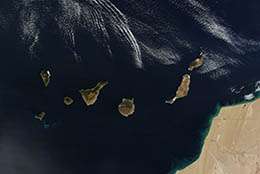Oceanic islands preferred thin crust

(Phys.org)—Debate over how and where oceanic island chains, like Hawaii, form, is at an end according to an academic from The Australian National University.
Dr Oliver Nebel from the Research School of Earth Sciences, in the ANU College of Physical and Mathematical Sciences, has been involved in a world-wide collaboration which sheds new light on the processes behind the formation of island chains. His findings are published in Nature Geoscience today.
"For a long time many have argued that some volcanic island chains, such as the Hawaiian Emperor Chain, are formed from things called hotspots. These hotspots come from the very deep interior of the Earth, where hot material rises in so-called mantle plumes," said Dr Nebel.
"These mantle plumes burn through the crust and erupt at the surface. As these hotspots are stationary, with the plates moving on top of them, they leave a track, creating chains.
"This theory poses some problems though, because if you look at hot spots, some have tracks, and others have none. Some are disturbed in their tracks: they appear somewhere and then they just vanish."
The international research team analysed rock samples taken from a range of hotspots in the South Atlantic Ocean. Their research found that it was the nature of the crust that was causing these oddities.
"We showed that the thickness of crust has a major effect on whether these mantle plumes can burst through," said Dr Nebel.
"For example, if you put a candle underneath cardboard and the cardboard is moving slowly enough, you can burn through it. But if you put a couple of pieces of cardboard on top of each other, the time may not be sufficient to burn through. Because the Earth's crust is very diverse there are parts where you can cut through and others not."
Dr Nebel said that he hopes his research solves the debate of the existence of plumes that lead to the formation of oceanic island chains.
"There has been a long debate about whether mantle plumes actually exist. Some use the disturbance in hotspot tracks as an argument against the existence of plumes," he said.
"What we found is that not only do these plumes exist, but the way they operate is quite complex. Both the crust and the source of the plumes are controlling the formation of islands. It's a more complex, diverse and dynamic system than we originally thought."
Journal information: Nature Geoscience
Provided by Australian National University



















